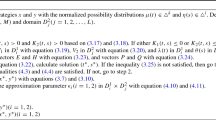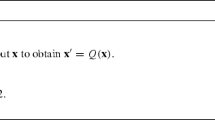Abstract
Bimatrix and polymatrix games are expressed as parametric linear 0–1 programs. This leads to an algorithm for the complete enumeration of their extreme equilibria, which is the first one proposed for polymatrix games. The algorithm computational experience is reported for two and three players on randomly generated games for sizes up to 14 × 14 and 13 × 13 × 13.
Similar content being viewed by others
References
NASH, J. F., Equilibrium Points in n-Person Games, Proceedings of the National Academy of Sciences, Vol. 36, pp. 48–49, 1950.
MILLHAM, C. B., On Nash Subsets of Bimatrix Games, Naval Research Logistics Quarterly, Vol. 74, pp. 307–317, 1974.
AUDET, C., HANSEN, P., JAUMARD, B., and SAVARD, G., Enumeration of All Extreme Equilibrium Strategies of Bimatrix Games, SIAM Journal on Statistical and Scientific Computing, Vol. 23, pp. 323–338, 2001.
MILLS, H., Equilibrium Points in Finite Games, SIAM Journal on Applied Mathematics, Vol. 8, pp. 397–402, 1960.
MANGASARIAN, O. L., and STONE, H., Two-Person Nonzero-Sum Games and Quadratic Programming, Journal of Mathematical Analysis and Applications, Vol. 9, pp. 348–355, 1964.
MANGASARIAN, O. L., Equilibrium Points of Bimatrix Games, SIAM Journal on Applied Mathematics, Vol. 12, pp. 778–780, 1964.
VOROBEV, N. N., Equilibrium Points in Bimatrix Games, Theoriya Veroyatnostej i ee Primwneniya, Vol. 3, pp. 318–331, 1958 [English Version: Theory of Probability and Its Applications, Vol. 3, pp. 297–309, 1958].
KEIDING, H., On the Maximal Number of Nash Equilibria in a Bimatrix Game, Games and Economic Behavior, Vol. 21, pp. 148–160, 1997.
VON STENGEL, B., New Maximal Numbers of Equilibria in Bimatrix Games, Discrete and Computational Geometry, Vol. 21, pp. 557–568, 1998.
KUHN, H. W., An Algorithm for Equilibrium Points in Bimatrix Games, Proceedings of the National Academy of Sciences, Vol. 47, pp. 1657–1662, 1961.
LEMKE, C. E., and HOWSON, T. T., Equilibrium Points of Bimatrix Games, SIAM Journal on Applied Mathematics, Vol. 12, pp. 413–423, 1961.
DICKHAUT, J., and KAPLAN, T., A Program for Finding Nash Equilibria, Mathematica Journal, Vol. 1, pp. 87–93, 1991.
MCKELVEY, R. D., and MCLENNAN, A., Computation of Equilibria in Finite Games, Handbook of Computational Economics, Edited by H. M. Amman, D. A. Kendrick, and J. Rust, Elsevier, Amsterdam, Holland, Vol. 1, pp. 87–142, 1996.
WINKELS, R., An Algorithm to Determine all Equilibrium Points of a Bimatrix Games, Game Theory and Related Topics, Edited by O. Moeschlin and D. Pallaschke, North Holland Publishing Company, Amsterdam, Holland, 1972.
AUDET, C., Optimisation Globale Structurée: Propriétés, Equivalences et Résolution, PhD Thesis, École Polytechnique de Montréal, pp. 91–109, 1997.
JÚDICE, J., and MITRA, G., Reformulations of Mathematical Programming Problems as Linear Complementarity Problems and Investigation of Their Solution Methods, Journal of Optimization Theory and Applications, Vol. 57, pp. 123–149, 1988.
AUDET, C., HANSEN, P., JAUMARD, B., and SAVARD, G., Links between Linear Bilevel and Mixed 0-1 Programming Problems, Journal of Optimization Theory and Applications, Vol. 93, pp. 273–300, 1997.
HOWSON, J. T., Equilibria of Polymatrix Games, Management Science, Vol. 18, pp. 312–318, 1972.
QUINTAS, L. G., A Note on Polymatrix Games, International Journal of Game Theory, Vols. 18–19, pp. 261–272, 1989.
COTTLE, R. W., and DANTZIG, G. B., Complementary Pivot Theory of Mathematical Programming, Mathematics of the Decision Scienes, Part 1, Vol. 11, pp. xxx–xxx, 1968.
YANOVSKAYA, E. B., Equilibrium Points in Polymatrix Games, Latvian Mathematical Collection, Vol. 8, pp. 381–384, 1968.
COTTLE, R. W., and DANTZIG, G. B., Linear Programming Extensions, Princeton University Press, Princeton, New Jersey, 1963.
LEMKE, C. E., Bimatrix Games Equilibrium Points and Mathematical Programming, Management Science, Vol. 11, pp.xxx-xxx, 1965.
EAVES, C. B., Polymatrix Games with Joint Constraints, SIAM Journal on Applied Mathematics, Vol. 24, pp. 418–423, 1973.
HOWSON, J. T., and ROSENTHAL, R. W., Bayesian Equilibria of Finite Two-Person Games with Incomplete Information, Management Science, Vol. 21, pp. 313–315, 1974.
MYERSON, R. B., Game Theory: Analysis of Conflict, Harvard University Press, Cambridge, Massachusetts, 1997.
Author information
Authors and Affiliations
Additional information
Communicated by P. M. Pardalos
The authors thank Bernhard von Stengel for constructive comments on the contents of this paper.
Rights and permissions
About this article
Cite this article
Audet, C., Belhaiza, S. & Hansen, P. Enumeration of All the Extreme Equilibria in Game Theory: Bimatrix and Polymatrix Games. J Optim Theory Appl 129, 349–372 (2006). https://doi.org/10.1007/s10957-006-9070-3
Published:
Issue Date:
DOI: https://doi.org/10.1007/s10957-006-9070-3




